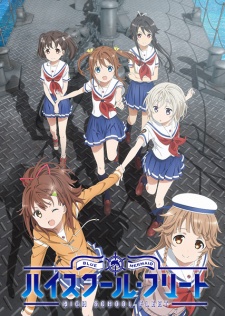
There’s something about being on the wide open seas—both in dealing with naval combat and in being cut off from the outside world—that lends itself to feeling more isolated and dangerous, even with a story built on the tried and true formula of “cute girls doing cute things.” And if Kantai Collection advertised itself as being seven parts slice of life to three parts action, then a work like High School Fleet that splits its time right down the middle has plenty more tension to work with. As the show begins with two girls who aspire to be the famous sailors known as Blue Mermaids, then skipping ahead to them entering their formal nautical education in high school alongside an assorted cast of wacky personalities and characters, there’s a sense that the show will be fairly laid back, dealing with an ocean setting rather than an ocean plot. Yet by the end of the first episode the crew of high school girls on board the Harekaze, where we'll be spending the rest of the show, have been declared mutineers for defending themselves against an attacking ship led by one of the school’s administrators. Suddenly they're very alone, hemmed in by lonely open seas and the looming presence of an untold number of ships looking to bring them back in chains.
It's actually a while before the slice of life antics even begin, as the early episodes are spent reeling from the shock of having the entire premise flipped upside down right at the start. There are a collection of naval battles that the Harekaze crew has to fight in order to escape unscathed, but even as they use dummy torpedoes and other non-threatening artillery they develop more and more of a reputation, digging themselves even deeper into the hole. Obviously something is wrong, but what? Only towards the end of the show do we figure out what is going on, and while the result feels both pseudo-scientific and a letdown, it serves its purpose well in creating tension early on, as well as setting up an inevitable final conflict that is no less intense than the pervasive atmosphere at the start.
With these sources of concern and the realities of living on limited resources out on open water, the actual comedy coming in does feel refreshing and relaxing, albeit a bit out of place with the rest of the story. Even these slice of life moments are tooled towards nautical issues, such as shopping for essential goods and holding a festival traditionally used to pray for good seafaring winds in the tenuously calm waters at the equator. Of course the comedy itself more has to do with the characters and their personalities, which are mostly combinations of past tropes such as the gung-ho engineer and the quiet but warm-hearted gunner, but High School Fleet has moments where these characters work together in hilarious ways where many slice of life shows tend towards showing comic personalities at conflict. My favorite example is the equator festival; as the festivities kick off and every crewmember is required to do some sort of presentation or show, in a group or by themselves, we get some truly organic stand-up comedy routines, demonstrations, and songs. It felt distinctly like a filler episode, but it's a surprisingly rewarding filler episode.
These personalities also fit well during the actual naval scenes, helped by the high level of attention to correctly rendering the technical aspects of ships. Hearing the energetic head engineer yelling in her odd dialect is amusing, but hearing her yell about what speeds the ship can and can’t take when factoring in heat and resource constraints is engaging and fun. The nervous girl behind the wheel may have personal issues about being there for the crew and doing her part that wear somewhat thin, but for every scene of somewhat superficial emotional trouble there are two of her micromanaging the ship’s speed and direction at the behest of the captain. Watching the combat and seeing shots miss their mark, or seeing the ships readjust their alignment and distance with respect to their relative specs, I was distinctly reminded of the tank scenes from Girls und Panzer, and so finding out that they shared a lot of the same scriptwriters came as little a surprise. It goes beyond loving the idea of ships and the sea; it is clear that they actually love ships and the sea, down to the most minute details and the most unfavorable or unpleasant conditions that come with it.
There is some dead weight near the middle of the show where the hidden details of the plot become clear in tandem with the central characters stagnating and becoming paralyzed with fear and apprehension, but there was never a time where the show felt like it was permanently headed in the wrong direction, nor did it ever feel unenjoyable. The opening episode was perhaps stronger than the show could maintain for too long while still remaining lighthearted, but towards the end both the comedy and the intensity of the show reach their peak, distinctly separate rather than working together but not at all lacking. The final few shots of the show leave a surprisingly strong impact as well, capturing a sense of relief, tragedy, and unity all at once, as well as a clear feeling of resolution and closure, confidently wrapping up our voyage on board the Harekaze. When I look back and see that the whole journey took us twelve episodes, I feel like no time has passed at all. I wonder if that’s the feeling the girls—and sailors everywhere—experienced as well.